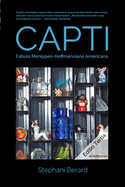by Stephen Berard
REVISED 3rd EDITION NOW ON SALE AT AMAZON
Plot Summary

In Capti, Stephen Berard weaves a multicultural, particolored, sometimes surreal and often hilarious tapestry of satire, magic realism, myth, science, and poetry that causes the reader to pinch himself, asking if he can actually be reading something like this in Latin. The central character is a highly functional autistic Seattle ballet dancer, Woody Fava, who speaks in verse and who uses chromoptic therapy in the form of colored eyeglasses to help himself make sense of his world. In search of the Goddess, whom he is sure has recently moved into a condo somewhere in Seattle, Woody quits his ballet job, quickly impoverishes himself, and has a series of disturbing misadventures, until finally disappearing…only to reemerge in Los Angeles at the center of a bizarre murder mystery. But this is only part of the story since Woody’s life is reflected and refracted into a thousand other tales – yes, hints of Scheherazade! – lived out in other times and other contexts.
Stephen Berard has recently revised his Menippean fable, the first in the Sphinx Heptology. Based loosely on two novelas by the German Romantic author E.T.A. Hoffmann, Prinzessin Brambilla and Das Fräulein von Scuderi, this poetic novel uses primarily literary fantasy and satire to explore the ways in which all living beings are either trapped or impaired or both (the Latin participle captus actually means both) but how they are also all somehow interconnected.
Although Berard has chosen an ancient literary form called the Menippean Fable, many of his compositional principles are derived from Hoffmann himself, the inventor of fantastic realism and great-grandfather of the now popular magic realism. In magic realism — among whose principal exponents have been Gabriel Garcia Marquez, Miguel Angel Asturias, Jorge Luis Borges, Richard Brautigan, William Burroughs, Italo Calvino, Carlos Fuentes, and Virginia Woolf — a given story will normally seem realistic, although here and there, just under the surface of things, some kind of magic is at work. In Hoffmann’s earlier fantastic realism, however, which Berard is cultivating in this book, realism alternates with utmost fantasy, and it is the job of the reader to establish the connections between these two modes.
Berard superimposes thoroughly modern themes and thought patterns on ancient literary genres and styles, emulating the hexameters of Juvenal, Lucan and Lucretius. In the prose portions of the first chapter, long, involved, sometimes misshapen sentences of an Apuleian type reflect the characters’ emotions, confusions, and a generally rather Fellini-esque kind of exuberance. The style, however, varies from passage to passage. Poetic verse forms evolve gradually from hexameters to medieval meters to modern blank verse...which in turn represents changes in, or the outright dissolution of, the world of the various protagonists as well as providing a pleasant lesson in modern poetics.